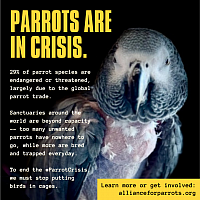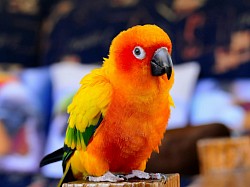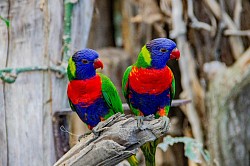Bridlington Parrot Sanctuary
The Parrot Crisis!
The Parrot Crisis: Don't Breed, Don't Buy - Foster a Homeless Bird
Since the 2007 EU Commission ban on importing wild birds into Europe, domestic breeding has surged dramatically. This surge has created a significant overpopulation problem, with thousands of baby birds hatching every year. The main issue is that parrots have become more accessible, leading many to end up in homes unprepared for the long-term commitment these birds require.
Many parrots—who can live up to 80 years—are abandoned or passed from owner to owner within just a couple of years. This situation has overwhelmed bird rescues and sanctuaries, which are struggling to house the growing number of displaced birds. For more details on the 2007 EU ban, please visit here.
The root cause of this overpopulation crisis is impulsive buying driven by a lack of proper education. Parrots are fascinating and intelligent creatures, well-known for their talking abilities and playful personalities. However, what is often overlooked is the significant time and effort required to train and socialize them properly, as they are not naturally domesticated.
It is important to remember that not every parrot will exhibit all these behavioral problems; each bird is unique. Some may appear well-adjusted initially, but can develop issues if they do not receive appropriate care and attention. Without intervention and proper training, these problems tend to worsen over time, making the bird’s situation more challenging.
The Challenges of Keeping Parrots as Pets
The Need for Constant Companionship and Stimulation
Certain parrot species require continuous companionship and ample mental and physical stimulation from their owners to closely mimic their natural environment. Without opportunities to express their full range of natural behaviors, some actions can become exaggerated—for example, birds may over-preen to the point of feather loss.
Dispelling the Myth of Easy Parrot Care
There is a common misconception that parrots are easy pets to keep—simply providing a cage and seeds is sufficient. However, this is far from true. Parrots differ significantly from cats or dogs, as they have not undergone thousands of years of selective breeding to adapt to living with humans. Their behavior still closely reflects the challenges they face in the wild.
Emotional Well-being and Behavioral Challenges
These highly intelligent and emotionally sensitive creatures spend their entire lives in captivity, which is essentially a sentence for the “crime” of their beauty. On an emotional level, parrots can quickly develop anxiety, depression, or obsessive behaviors, which can cause long-term harm. Many problematic behaviors that lead to birds being surrendered—such as screaming, biting, and guarding their territory—often stem from insufficient social interaction or environmental enrichment.
Complex Dietary Needs
In addition to behavioral care, parrots’ dietary requirements are more complex than many new owners realize. Their diet must extend beyond seeds to include a balanced mix of specialized pellets, fresh fruits and vegetables, and cooked foods. Seeds and nuts act like the “fast food” of the parrot world—high in calories and highly palatable, similar to chocolate or pizza for humans. Just as a diet of only pizza would be unhealthy for people, a seed-only diet can lead parrots to develop fatty liver disease.
Household Hazards to Parrots
Many common household items are toxic to parrots, including avocados, cleaning products, Teflon-coated cookware, certain houseplants, perfumes, and candles. Parrots have highly sensitive respiratory systems and, as prey animals, often conceal signs of illness. They can become seriously ill or even die without showing obvious symptoms. Even if a bird appears unaffected by a new air freshener, it is crucial to consult updated lists of known toxins regularly.
Need for Enrichment and Natural Behaviors
Parrots require daily access to toys and objects they can chew and destroy. When healthy, they can be noisy and messy—traits that worsen with neglect. Their natural instinct is to break down wooden materials. Most importantly, parrots are designed to fly, and by restricting their natural flying space, humans assume the lifelong responsibility of providing sufficient stimulation to meet their complex needs. Without adequate enrichment, birds may resort to self-harm out of boredom and stress.
Suitability as Pets and the Growing Population
In many respects, parrots are not well-suited to be pets—not due to inconvenience for humans, but because captivity is challenging for the birds themselves. They do not thrive in cages, and many aspects of typical homes can be hazardous to them. Nevertheless, parrots remain popular pets, and their captive population continues to grow.
The Importance of Education and need to Stop Breeding Parrots
Their welfare can be maintained with dedication and understanding, but increasing breeding—especially by amateurs and hobbyists—and a lack of proper education have resulted in birds, which can live up to eighty years, being treated as commodities. Breeding rates now exceed the hobby’s capacity to provide suitable homes.
It is essential to promote proper education, and raise public awareness about the overpopulation crisis. Breeders need to take more responsibility and think about the suffering that breeding and hand rearing causes birds and turn to getting involved with bird rescue, instead.
Current Statistics and the Need for Action
New Life Parrot Rescue estimates that approximately two thousand birds enter the UK pet trade each week, totaling around one hundred thousand annually. Many birds are already awaiting good homes, and statistics indicate that at least half of the chicks will join this group sooner rather than later.
Sanctuaries are overwhelmed with birds, while suitable homes are scarce. Therefore, continuing to breed Parrots, Parakeets, Cockatiels, Budgies, and Lovebirds at this time is neither humane nor responsible.




